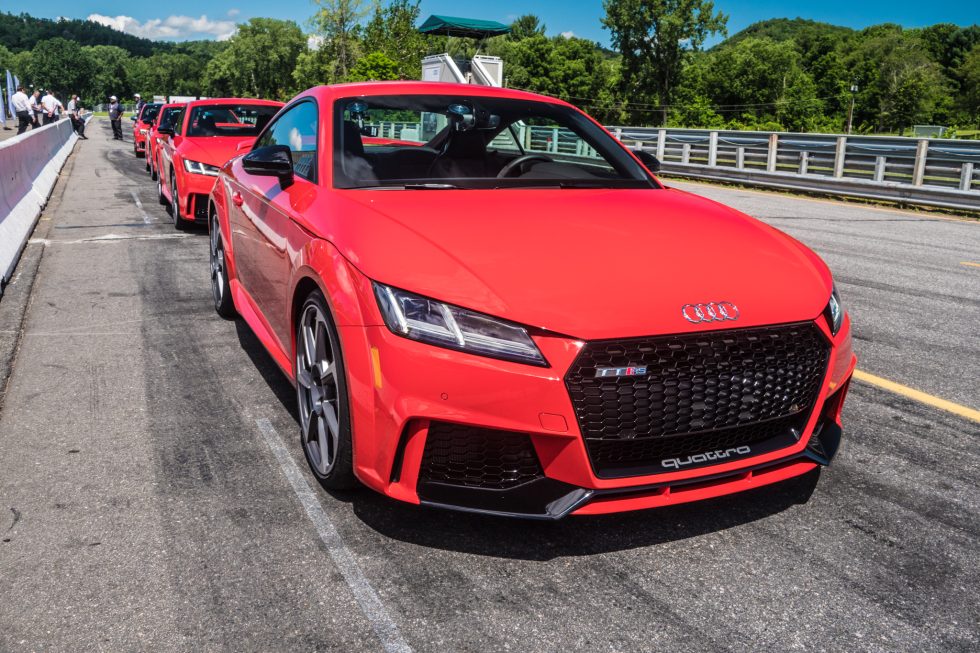We usually pay for our own travel expenses, but in this case Audi provided flights to New York City and two nights’ accommodation. While we have paused all sponsored travel opportunities at this time, this event took place in July before that moratorium began.
SALISBURY, Conn.—Success on the racetrack doesn’t sell cars like it used to. That said, plenty of car companies still go racing. And it’s not just a marketing exercise; it remains an engineering one, too. Competition breeds ingenuity, and a motorsports department is like a skunk works that can add a halo to a mundane car or turn an already good one all the way to 11. BMW has M. Mercedes-Benz has AMG. Volvo (yes, that Volvo) has Polestar. And Audi has Audi Sport.
We were quite smitten with Audi Sport’s handiwork when we tested the R8 this summer, but, given that car’s bones, it was bound to impress. Finding out what Audi Sport’s engineers can do with more modest beginnings was the reason we headed up to Lime Rock Park, a scenic race track a couple of hours north of New York City. Well, that, plus we were promised a hot lap with racing legend Hans Stuck in the driver’s seat.
The TT-RS and RS3 share more than just Audi Sport’s coveted RS (for RennSport, “racing sport” in English) badge. Both use the same MQB architecture. They even use the same 2.5L TSFI engine. But after a day spent lapping them on track and driving them on the street, we were somewhat shocked at just how different each car turned out to be. One completely blew our socks off, while its sibling underwhelmed in comparison. To find out which was hot and which was not, buckle up.

A five-cylinder family tree
MQB—or modular transverse toolkit—is the starting point of every transverse-engined car built under the VW Group umbrella since 2011. It’s a common architecture, which means it uses standardized and interchangeable parts but with a constant engine and front axle position. What it’s not is a common platform, so MQB cars can (and do) vary wildly in size and shape.
These two cars share an identical five-cylinder heart, though. The “straight five” layout is uncommon, but there are some advantages. Each cylinder in a four-stroke engine fires once for every two rotations of the crankshaft. So in a boring old four-cylinder motor, that happens every 180 degrees; as one piston reaches the end of its power stroke the next begins, and so on. When you start to add more cylinders, the power strokes have to overlap—with five cylinders, the engine fires every 144 degrees, providing 36 degrees of overlap. The result is a smoother delivery of power.
However, the same is true for a straight six, which is also inherently balanced and, so, free of vibrations that afflict inline engines with fewer pistons. Engine snobs, therefore, point to the straight six as the ideal inline layout for internal combustion, even though they are mostly out of vogue. The issue is one of length; the need to fit crash structures means few can spare real estate under the hood to mount one, particularly when a V6 has just as many pistons and is 50-percent shorter. But a straight five will fit, transversely, between the front wheels of a car.
It’s a choice from left field but one heavy with meaning here. Audi’s badge has four rings, but its reputation was built on five cylinders. The Quattro coupé arrived in 1980, powered by a turbocharged (longitudinal) five. Coupled with all-wheel drive, it was a capable all-weather performance car, but its exploits in motorsport conferred legendary status. Drivers like Michèle Mouton, Walter Röhrl, and Stig Blomqvist won many rallies in Quattros, creating a legion of fans in the process.
Here in the US the rally cars made less of an impact, although Quattros did win at Pikes Peak five times in the six years between 1982 and 1987. In 1988, that distinctive five-cylinder engine note would be heard in the highly competitive Trans-Am series. Hans Stuck, Hurley Haywood, and Walter Röhrl used their 507hp Audi 200s to good effect, winning eight of the 13 races. Stuck took four wins, Haywood the championship, and in response the SCCA banned all-wheel drive and foreign engines from the series. So the following year, Audi switched its attention to IMSA’s GTO class, bolting on an even bigger KKK turbocharger along the way. With 720hp in his Audi 90 Quattro, Stuck blitzed seven of the 12 races Audi entered.
The engines that powered Stuck and co. on to glory share nothing with that of the engine of TT-RS and RS3 beyond cylinder count and firing order (1-2-4-5-3 for those who care). The new engine really is brand new, replacing the same capacity motor that powered the previous generation TT-RS and last year’s RS3. Many of the changes involved weight reduction. An aluminum engine block, magnesium oil pan, and hollow crankshaft all conspire to save 57lbs (26kg).
Both direct and port injection are employed, the latter in cases where it helps low-speed emissions. Variable valve timing does its bit, too, altering the duration the exhaust valves are open for better fuel efficiency at low speeds versus when hard acceleration is the order of the day. The BorgWarner turbocharger has had its wick turned up; boost is now 19.6psi (1.35bar) and compression is 10:1. The net result of all this is a compact but powerful engine, providing both cars with 400hp (294kW) and 354lb-ft (480Nm).
Listing image by Audi



